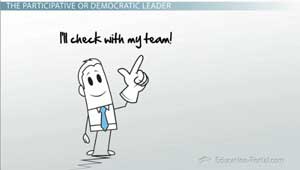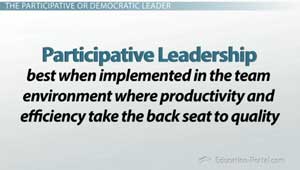The Participative or Democratic Leader
After you watch the video and know the material, click HERE for the quiz.
Explore the approach that a participative or democratic leader takes. In this lesson, you'll learn about the advantages and the drawbacks associated with this particular leadership style.
Sharing is Caring
Today it seems like people are sharing everything from Facebook posts to spouses. It's a concept we learned early on when we had to share toys, rooms, food, even secrets with other kids - even though some of us hated it at the time. However, some of us enjoyed the process of sharing with others and still do as adults. And no, I'm not talking about on Facebook or swapping your wife for the week with another person; I'm referring to managers who share with their subordinates.
The Participative or Democratic Leader
Those leaders who take the time to share with their employees and encourage their participation in the decision making process are accordingly referred to as participative leaders, or otherwise known as democratic leaders. The two terms are really one in the same and describe a leader who includes subordinates in the decision making process by encouraging employees to be creative, innovative and engaged in projects.
 |
 |
In turn, subordinates are more involved and willing to work towards whatever decisions are being made due to the vested interest they have as a result of being a part of the decision making process. Employees tend to have a higher level of productivity and job satisfaction because they feel valued by their manager and that what they say or feel actually matters. The democratic leader essentially empowers the subordinates by recognizing the valuable contributions they can make during the decision making process. Employees become less competitive and more cooperative with one another, creating a welcoming organizational culture that people like to be a part of.
 |
 |
Therefore, the decision making process can be extremely slow at times under the democratic leader, but inevitability lead to good results. The question becomes: is it worth the wait? There are certainly times where speed or efficiency is essential, making the democratic leadership style ineffective. Employees might also resent the participative leader who only listens to their ideas but never implements them. They want to be able to express their ideas and see them put into action, otherwise it can lead to low motivation, skepticism and feelings of betrayal. Even worse, the employees might not have the knowledge, skills or expertise to provide high quality input during decision making. The participative leadership style is best when implemented in the team environment where productivity and efficiency take the back seat to quality.
 |
Pablo the Participative Leader
To better understand the participative leadership style, let's look at the following example of Pablo the night club manager at Pretty in Pink. As an organization, Pretty in Pink has a very relaxed and team-based culture. The day-to-day operations do not change much, however once a month the owner asks Pablo and his team to come up with a way to promote the club and set it apart from the rest of the local clubs in the area. Next month is February and Pablo wants to decide what promotion or event they will have to promote at the club.
As a participative leader, Pablo does not make decisions alone. Instead, Pablo calls a meeting with all of his staff so that they can begin to brainstorm some ideas. Pablo spends time encouraging his employees to be creative, innovative and engaged in the project. To be sure that everyone feels valued, he asks each team member to share an idea. And once everyone has been heard, they have a vote to determine which idea should be selected. This way, Pablo knows that each team member feels valued and a part of the decision making process, even if their initial idea is not selected. Once an idea is selected, Pablo asks his team to choose which area they would like to be responsible for and fills in the gaps afterwards to ensure that all of the work related to the project is completed on time. Being a participative leader works for Pablo and his team by encouraging the right amount of team member involvement to be successful and promote a high level of job satisfaction.
Lesson Summary
Let's review. The participative or democratic leader describes a leader who includes subordinates in the decision making process by encouraging employees to be creative, innovative and engaged in projects. In doing so, participative leaders believe that they gain a higher degree of understanding by including those people who are directly affected by the decisions being made. In turn, subordinates are also more involved and willing to work towards whatever decisions are made due to the vested interest they have as a result of being part of the decision making process. Employees tend to have a higher level of productivity and job satisfaction because they feel valued by their manager and what they say and feel actually matters. Employees become less competitive and more cooperative with one another.
Some of the drawbacks include delayed decision making, employees' resentment when their ideas are not implemented and a lack of employee knowledge, skills or expertise to provide high quality input. The participative leadership style is best when implemented in the team environment where productivity and efficiency take the back seat to quality.